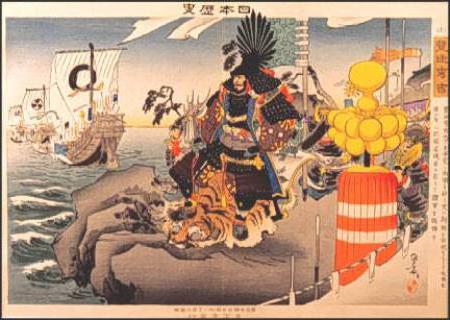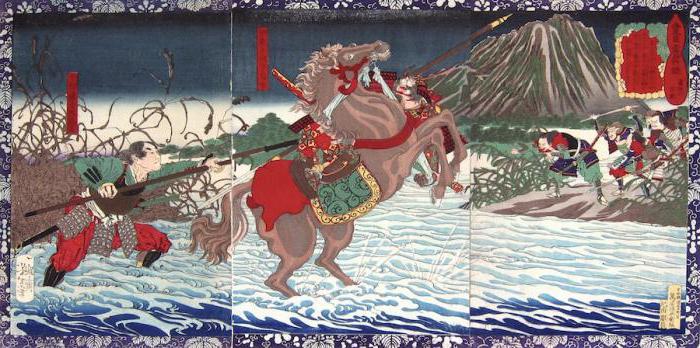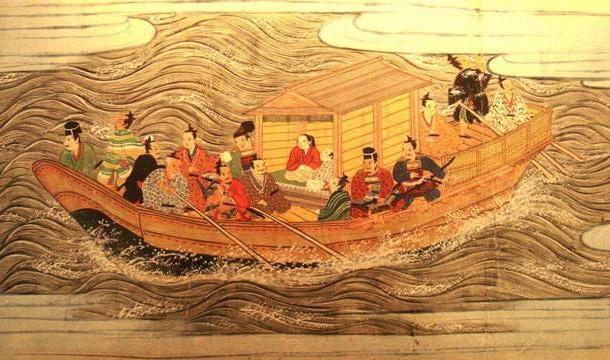Toyotomi Hideyoshi is a prominent military and political figure in medieval Japan who managed to reach the very top of the hierarchical system from among the peasantry. His reforms formed the basis for the structure of the Japanese state and existed practically unchanged for 300 years. Toyotomi's name is shrouded in secrets and legends, it is even to some extent a symbol of modern Japan.
Birth and youth
Toyotomi Hideyoshi was born either on February 2, 1536, or March 26, 1537, which corresponded to the fifth or sixth year of Tenbun, the exact date is still unknown. His small homeland was the village of Nakamura in the province of Owari. He was born into a peasant family, and if he were an ordinary child, then he would go to the field until the end of his days. However, Hideyoshi was not an ordinary person, and he managed to prove it to everyone, including the emperor. Although, perhaps, he was not a peasant, since other sources claim his samurai origin, moreover from the "black" layer - asigaru foot soldiers. This mystery remained unresolved even after four centuries after the death of Toyotomi Hideyoshi.
His brief biography is filled with many facts and events in the military and political life of the country. But it is likely that if his father had not died so early, Japan and the whole world would not have heard that name. The thing is that after the death of Yaemon’s father, his mother got married. The stepfather immediately disliked his wife’s son, often raised his voice at him and often beat him. This prompted the future ruler to flee from his father's house. He went to the province of Suruga, where the Imagawa clan ruled. T. Hideyoshi was hired by Matsushito Naganori with the new name Kinoshita Tokichiro. From this moment begins his adult life away from his father’s home and native land.
Oda Nobunaga and the beginning of growth in the hierarchical system
The year 1554 was marked by the meeting of Hideyoshi with Oda Nobunaga. At the same time, he left Imagawa and began to serve the new master. Of course, he did not immediately become a samurai, at first he was the bearer of Nobunaga sandals.

Toyotomi Hideyoshi stood out from among the simple servants, he was smart, prudent, and engineering inclinations slipped into his activities. The last paragraph helped change the attitude of the ruler. Once there was a collapse of the fortified residence of Oda. The collapses were significant, but the capable peasant Toyotomi managed to eliminate them in just three days. This made an indelible impression on Nobunaga, and he, in turn, did not remain indebted to his servant. In an instant, Oda appointed him ruler of the city of Kiyosu, which had the status of a prizamkova, in addition, the financial affairs of the ruling family were transferred to Hideyoshi. Given the fact that Toyotomi was not of aristocratic origin, this was an exception to all the rules. He managed to consolidate his high status in society in 1564, when he married the daughter of the closest vassal Nobunaga Asan Nagamashi.
Military activities led by Nobunaga
Oda Nobunaga is a historical figure who played a huge role in the unification of Japan. As a rule, the unification took place due to the conquest of neighboring provinces, therefore it was accompanied by constant internecine wars. Toyotomi Hideyoshi played a large role in this process. His biography is simply crammed with military successes in the struggle for the exaltation of the Oda clan. In 1566, a war was unleashed with the Saito clan. The stumbling block was the province of Mino. Hideyoshi managed to erect a fortification in a swamp in just one night, which became a springboard for the advancement of Nobunaga’s troops. However, it should be noted his diplomatic abilities, because it was in this resistance of the two Japanese families that he lured Saito’s influential generals to his side. After this, a turning point occurred during the war, and two years later it ended in the victory of Oda.
1568 was an important year in Hideyoshi Toyotomi's political activities . After the capture of Kyoto, he was appointed one of the co-rulers of the capital.
From upstart to generals
Two years after the capture of Kyoto, Nobunaga gathered an army to march on the province of Etizen, where the Asakura clan ruled. This campaign suffered unexpected possible losses and the complete defeat of Oda's troops. Already during the campaign, Nobunaga learned about the betrayal of one of the influential allies, with whom the enemy could take the army in a vice and defeat. Oda prepared for an urgent retreat, and left a rearguard led by Hideyoshi as a cover. Everyone perfectly understood that this was certain death. However, contrary to all the prejudices of Toyotomi, he managed to repel all the enemy raids, returning to Kyoto to the main forces of the undefeated. This act was not just a cover for the retreating forces of the ruler, he changed the views of the samurai Oda. Previously, they believed that Hideyoshi was a simple civilian upstart, but now they began to see a gifted commander in it.
In 1573, the Adzai family was destroyed, while Toyotomi Hideyoshi was appointed the ruler of Nagamaha Castle in the territory of Ome. Photos of those possessions did not reach our days, but the fact that the former peasant received military fortification for use speaks volumes.
In 1576, Hideyoshi was appointed assistant general of the military, Katsuie Shibata, to repel Kenshin's military onslaught. During the discussion of the battle strategy, a quarrel occurred, as a result of which our hero went AWOL - left the headquarters. The result was a complete defeat of the Nobunaga troops. Initially, it was decided to execute Toyotomi, but given his remarkable abilities, the lord left him alive, issuing a strict warning.
Atonement
Toyotomi Hideyoshi's activity dates from the second half of the 16th century. This is the peak of a tense struggle within the state between individual representatives of the clans, this is a time of ongoing wars. And so the best way to earn the forgiveness of a ruler was a military feat. Toyotomi did not take long to wait, especially since the command itself gave him a convenient chance for this. He was appointed commander of the Nobunaga army in the fight against the growing Mori clan. In two years, Hideyoshi managed to subjugate three powers to his power - Koder, Akamatsu and Bessho. At the same time, he created a stronghold, the center of which was Himeji Castle. In 1579, it turned out to lure Ukita, vassal Mori to his side.

However, the next year was not so cloudless. Besse’s clan rose in the rear. Hideyoshi could not continue the offensive when the rear was troubled, so he returned his forces to suppress the rebellion. In order to take the fortress of the rebels, it was necessary to spend a year, since this was possible to do only by starvation. Immediately after this, Toyotomi subjugated the Tajima region, which belonged to the Yaman clan, to his power. The remains of Yaman's subordinates, realizing the complete failure of their overlord, expelled him and concentrated in Tottori fortress, going over to the side of Mori. But this did not save them: in 1581, Toyotomi surrounded the fortress, bought up all the provisions in the district and took it to death.
In 1582, as in the previous one, Fortune smiled at our hero Toyotomi Hideyoshi. The photo of his victories, of course, does not exist, but if they were captured, future generations would also amaze contemporaries. In the meantime, Toyotomi continued his victorious series and, invading the lands of Bittiu province, began a siege of the Takamatsu fortress. It was a well-armed and impregnable castle. On all sides, the valley in which he was surrounded by mountains, and on both sides of it passed two rivers. Hideyoshi again resorted to engineering, constructing dams in such a way that the whole valley, coupled with incessant rains, turned into a huge lake, and the castle itself turned out to be an island. A few weeks later, the impregnable fortress fell.
Political elevation
The years of the reign of Oda Nobunaga cannot be called stable and prosperous. The population suffered from constant ongoing wars. With his power, he managed to capture 33 provinces in which he created indescribable atrocities. All this led to a rebellion against Nobunaga. The rebels, led by Akechi Mitsuhide and his 10,000th army, forced Nobunaga to commit seppuku.
At this time, Toyotomi was busy storming Takamatsu Castle, but when he heard of a disturbing message, he didn’t tell anyone, concluded a truce with Mori in a short time and went to the capital. At the same time, another associate of Nobunaga - Tokugawa Ieyasu went to Kyoto. But Hideyoshi was ahead of him, having covered a distance of several hundred kilometers in three days. In May, 12 days, in 1582, the forty thousandth Toyotomi army defeated the Mitsuhide troops under Yamazaki. The rebel himself was killed by simple peasants while robbing food for horses.
Toyotomi Hideyoshi, whose quotes scattered throughout Nobunaga's former possessions, positioned himself as an avenger, which led him to increase influence among influential feudal lords and samurai. When deciding on the inheritance of power, Toyotomi was not difficult to enlist the support of the generals. He forced a potential rival for the throne - Nobunaga’s son Nobutaku — to commit suicide. Then Hideyoshi received most of the possessions of the Oda clan, being regent adviser to the new ruler of the Oda Sanboshi clan (3 years old). At the same time, open discontent was indicated by a longtime opponent of Shibat Katsiyu.
Unification of the country through bloodshed
Toyotomi Hideyoshi (1582-1598) did not find peace after the declaration of Nobunaga's power as his actual heir. At that time, a longtime enemy and opponent of Hideyoshi Shibata unleashed a war against him. In the decisive battle, the enemy was defeated and was forced to retreat to his province of Etizen. Most of Shibata's allies eventually came under the banner of Toyotomi. Taking the moment, Hideyoshi burst into enemy lands and surrounded Kitanosyo fortress. Shibata and his wife took death from seppuku, the citadel surrendered to the conqueror. As a result, all former lands controlled by Nobunage passed into Hideyoshi's possession.

In 1583, the city of Osaka became the center of construction: the construction of a huge castle unfolded here. As contemporaries testified, no state of the civilized world had such fortresses. According to the Japanese, these included Japan, China and Korea. At the same time, Osaka became the main financial center and the unofficial but actual capital of the country.
Subjugation of the entire territory of Japan
The richest competitor in the process of unification of the country for Toyotomi was Nobunaga’s former ally Tokugawa Ieyasu. In 1584, a general battle took place between their armies, in which the Samurai of the Tokugawa won. But the potential and reserve of forces to continue the war was on Hideyoshi's side, so Ieyasu went for peace talks. Toyotomi had little peace, he needed the submission of absolutely all the city governors of Japan. To do this, he even married his sister Asahi to marry Tokugawa, and his mother sent him as a hostage. In 1586, Tokugawa himself arrived Kyoto and swore allegiance to Hideyoshi.
In those same years, Toyotomi Hideyoshi decided to annex the island of Shikoku, on which Tesokabe Mototiki ruled, to join his possessions. In the beginning, Hideyoshi suggested that he simply acknowledge the vassality. But, as expected, Tesokabe refused, after which Hideyoshi sent a 100,000-strong army, before which the enemy capitulated.
Then came the island of Kyushu, ruled by the Shimazu clan. In 1587, Toyotomi personally led the 200,000th army. Local governors could not resist such a force and surrendered to the conquerors.
By the end of the 80s of the 16th century, another major landowner remained in Japan - the genus Go-Hojo. In 1590, an open war broke out between the two titans. Toyotomi besieged the main fortress of Odawara. Immediately after this, he ordered all the samurai in the eastern part of Japan to gather in his residence. As a result, almost all military feudal lords came to him and recognized their dependence on Hideyoshi. After three months of siege, an impregnable fortress that not one famous commander could take before Toyotomi fell. The ruler of the clan and his sons committed seppuku.
As a result of this activity, under the influence of Toyotomi Hideyoshi, the commander and politician subjugated the entire territory of Japan to his power. He became the most influential ruler in the history of the state.
Internal reforms
In the internal affairs of Toyotomi Hideyoshi was as active as in military operations. After the end of the century of civil wars in the country, a period of stability began, which entailed an instant increase in cultivated areas - they grew by 70%. However, Hideyoshi introduced a huge tax on farmers - they had to lease 2/3 of the harvest to the treasury. Thus, the rice harvest for the year amounted to about 3.5 million tons.
Toyotomi pursued a policy of seizing all weapons among the common population, and even braids and sickles belonged to this category at that time. The entire population of Japan was clearly divided into two classes: administrators, which included the military estate, and civilians. The All-Japan Land Cadastre was first created also during the reign of Hideyoshi and lasted unchanged for 300 years.
One of the most significant moments in Hideyoshi's internal activities is the expulsion of Christian missionaries. There were a lot of reasons for this, from official economic to personal ones. On June 19, 1587, he issued a decree according to which all Christians were to leave the Japanese islands within 20 days, otherwise they would die. For intimidation, indicative executions were carried out: 26 Christians were crucified, including Europeans.
Imperialistic views of Toyotomi Hideyoshi
Intoxicated by internal successes, believing in his God-chosenness, Toyotomi began to gradually go crazy, as some researchers claim. He got himself a harem, consisting of 300 concubines, all the time drove hundreds of thousands of peasants to build military fortifications, and nobody needed them. But the main thing is his imperialist ideas. Toyotomi came up with the idea of capturing the entire civilized world. He began with Korea. The first period of the war, undoubtedly, remained with the Japanese - they seized almost all the cities on the Korean peninsula and reached the borders with China. However, after this a guerrilla war unfolded , plus the Chinese army came to this from the north, considering Korea their vassal territory. The result - the samurai were pushed south. Korea was divided into Chinese and Japanese zones of occupation. This struggle continued until Hideyoshi's death in 1598. After this event, the samurai capitulated and went to their native lands, where the internecine struggle broke out again, in which Tokugawa Ieyasu became the main figure.
So said Hideyoshi
Quotes and sayings, as well as poems by the omnipotent dictator Hideyoshi, were filled with deep philosophical meaning. However, this was characteristic of all the rulers of the civilized East of those times, and our hero is no exception.
By its origin, Toyotomi could not become emperor, so the title of campaign was assigned to him. It can be interpreted in different ways, but the point is that he was the de facto ruler of the state under the nominal power of the emperor. Therefore, when the samurai swore allegiance, the deviation was not made to the emperor, but towards the Hideyoshi campaign. This is evidenced by the main text of the oath, compiled directly by Toyotomi: "The orders and orders of the kampaku must be respected by all, and must be carried out implicitly."
One of the philosophical quotes of Hideyoshi is the argument about life: “I am unshakable and firm in achieving my goal, and in each new situation all my household chores will also be in perfect order. I hope, as before, look into the future, believe in my longevity, and nothing bad should happen to me. I will continue to enjoy all the charms of life. "
His quotes are full of philosophy of life, however, his statements regarding public administration, in which he was very strong, did not reach us. Hideyse has come a long way from a peasant to a campaign, and in his declining years, contemporaries claimed, turned into a very superstitious and pious man. That is why his last poem, already written on his deathbed, was the following philosophical conclusion:
I'm like a falling drop of dew
like a dewdrop that will disappear without a trace.
Even the castle in Osaka -
Just a dream.
Toyotomi Hideyoshi is “monkey” or “Mr. monkey”, which is what he was called in Japanese historiography. This did not come from his unseemly appearance. In Japan, such a nickname or the word "Tokichiro" called people who did everything in time, were endowed with a remarkable mind, quick wit and vitality. Toyotomi Hideyoshi proved all this by the example of his own life. He managed to become the ruler of all of Japan from a poor peasant, defeating opponents, and at the same time uniting the state under sole authority.